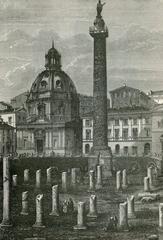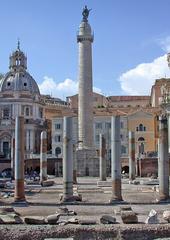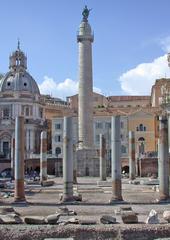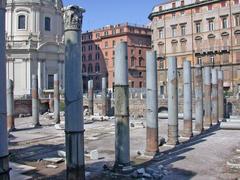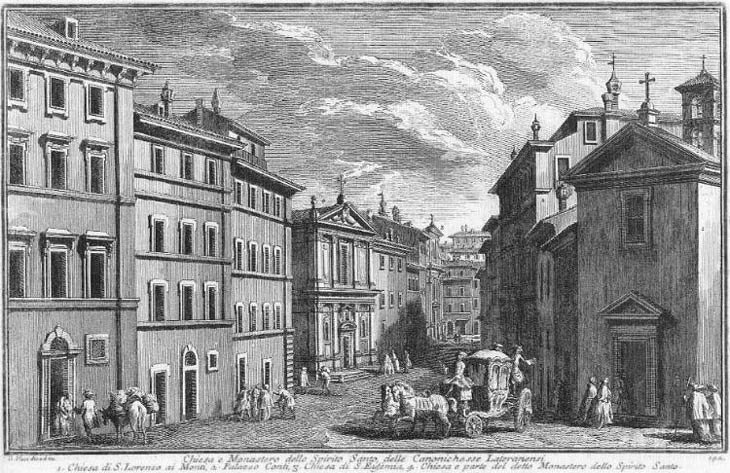
Basilica Ulpia: Visiting Hours, Tickets, and Complete Guide to One of Rome’s Premier Historical Sites
Date: 14/06/2025
Introduction: The Civic Heart of Trajan’s Rome
The Basilica Ulpia, a crown jewel of Trajan’s Forum in the heart of Rome’s Imperial Fora, is an enduring symbol of Roman architectural ingenuity, civic sophistication, and imperial power. Commissioned by Emperor Trajan and constructed between 106 and 113 CE, this monumental basilica was not a church but a bustling civic center. It was the largest basilica in ancient Rome, spanning approximately 170 meters in length and 60 meters in width. Designed by the famed Apollodorus of Damascus, its innovative use of Roman concrete, majestic Corinthian columns, and soaring timber roof set new architectural standards that would shape public and religious buildings for centuries.
Today, visitors can explore evocative ruins and a remarkable partial reconstruction completed in 2023, which rises over 23 meters, offering a vivid sense of the basilica’s original scale. This guide provides a comprehensive overview of Basilica Ulpia’s history, architectural highlights, restoration, and practical information to plan your visit, including opening hours, ticketing, accessibility, tours, and travel tips.
For detailed updates and historical background, consult trusted sources such as Wanted in Rome, Rome.net, and The Art Newspaper.
Table of Contents
- Introduction
- Origins and Construction
- Architectural Features and Innovations
- Civic Functions and Role in Roman Society
- Decline, Spoliation, and Rediscovery
- Modern Restoration and Current State
- Visiting Basilica Ulpia
- Frequently Asked Questions (FAQ)
- Legacy and Cultural Significance
- Plan Your Visit: Resources and References
Origins and Construction
Emperor Trajan envisioned the Basilica Ulpia as the architectural showpiece of his new forum, celebrating his family line—the Ulpii. Constructed between 106 and 113 CE and overseen by Apollodorus of Damascus, the basilica was a triumph of Roman engineering (Wanted in Rome). Measuring about 170 by 60 meters, it was the largest basilica the city had ever seen. Its concrete core was clad in rich marbles, and the entrance, accessed by a grand staircase of yellow Numidian marble, was framed by a monumental triple-columned portico adorned with intricate friezes.
Architectural Features and Innovations
Materials and Structure
The basilica’s design featured a vast central nave, flanked by double aisles on each side, separated by four rows of towering Corinthian columns—96 in total. The nave soared to a height of 25 meters, supported by arches and groin vaults, while clerestory windows flooded the space with light (Ancient Rome Live). The floors were inlaid with colorful marble (opus sectile), and marble panels lined the lower walls.
Columnar Arrangement
The double colonnade not only supported the roof but also created visual harmony and guided movement through the basilica. Honorary statues of emperors, deities, and civic leaders stood on marble bases, commemorating Rome’s elite from the age of Trajan to the sixth century CE.
Timber Roof
The roof, one of the largest timber structures in antiquity, was supported by massive trusses, likely made of cedar or fir. Its design allowed for a wide, unobstructed central hall, ideal for the basilica’s public functions.
Civic Functions and Role in Roman Society
The Basilica Ulpia was Rome’s principal secular basilica—hosting law courts, civil tribunals, and commercial disputes. It provided a dignified backdrop for imperial ceremonies, public announcements, and acts of generosity such as debt cancellations. The apses may have held records of citizenship and manumission, underscoring the basilica’s administrative importance (My Rome Pass; Visit Colosseum Rome).
Its architectural form influenced later basilicas throughout the empire and became the prototype for early Christian churches, with features like a central nave, side aisles, and apses.
Decline, Spoliation, and Rediscovery
The basilica continued as a civic hub until the rise of the Basilica of Maxentius in the fourth century. After the Western Roman Empire’s fall, it suffered neglect and spoliation—its marbles and columns repurposed for medieval churches and palaces (madainproject.com). A major earthquake in 801 CE accelerated its ruin.
In the 19th and 20th centuries, archaeological campaigns uncovered the basilica’s foundations, columns, and marble floors, providing insights into its grandeur (Wanted in Rome).
Modern Restoration and Current State
A major restoration began in 2021, funded by a €1.5 million donation. The 2023 reconstruction re-erected a two-storey colonnade, rising 23 meters and restoring a sense of the basilica’s awe-inspiring scale (The Art Newspaper). Controversial due to its funding, the project is widely recognized for enhancing public understanding and appreciation of Trajan’s Forum.
Today, visitors can walk among the reconstructed columns, view the basilica’s floor plan marked on the ground, and enjoy interpretive materials and digital reconstructions (ARTnews).
Visiting Basilica Ulpia: Hours, Tickets, and Travel Tips
Hours
- Open: Tuesday to Sunday, typically 9:00 AM – 7:00 PM (last admission 6:30 PM).
- Closed: Mondays and select public holidays.
- Note: Hours may change seasonally or during special events (e.g., Rome Jubilee). Always check the official tourism website before your visit.
Tickets
- Admission: Entry is included with the combined Imperial Fora ticket (covers Trajan’s Forum, Roman Forum, and Palatine Hill).
- Price: Around €16 for adults; reduced rates for EU citizens under 25; free for children under 18.
- Purchase: Tickets available online (recommended during peak seasons/Jubilee Year) or at the site.
- Guided tours and audio guides: Available for an extra fee.
Accessibility
- The site is partially accessible: Some ramps and flat surfaces, but uneven terrain and ancient steps may be challenging.
- Wheelchair users should contact visitor services for detailed information.
Tours and Events
- Guided tours in multiple languages are offered by official providers and reputable operators.
- Special events: During Jubilee Year and after restoration, look for exhibitions, cultural events, and educational workshops.
Nearby Attractions & Visitor Tips
- Nearby: Trajan’s Column, Markets of Trajan, Roman Forum, Colosseum, Capitoline Hill.
- Transport: Metro (Colosseo, Line B), buses, and trams serve the area. Allow extra time due to possible detours (especially near Piazza Venezia).
- Tips:
- Wear sturdy shoes for uneven terrain.
- Arrive early to beat crowds and summer heat.
- Combine visits for a full day of ancient Roman history.
- Respect preservation rules: Stay on marked paths; photography allowed, but drones/tripods need permission.
Frequently Asked Questions (FAQ)
What are Basilica Ulpia’s opening hours?
Tuesday–Sunday, 9:00 AM–7:00 PM (last entry 6:30 PM); closed Mondays. Check for seasonal changes.
How much do tickets cost?
Combined Imperial Fora ticket is ~€16 for adults, with discounts for EU youth and free entry for children under 18.
Is the Basilica Ulpia accessible for people with reduced mobility?
Partially; some areas are uneven. Contact site staff for details.
Are guided tours available?
Yes, in multiple languages; highly recommended for deeper insight.
Can I take photos?
Photography is allowed for personal use; check for restrictions on professional equipment.
How do I get there?
Easily accessible by metro, bus, or on foot from the Colosseum and central Rome.
Legacy and Cultural Significance
The Basilica Ulpia is a landmark in both Roman and Western architecture. Its longitudinal plan, double aisles, and apses became the template for Christian basilicas and Renaissance churches. Its civic role as a center for law, commerce, and public order made it a microcosm of Roman urban life. Even in partial ruin, the basilica evokes the grandeur and ambition of an empire at its zenith (Ancient Rome Live; madainproject.com).
Plan Your Visit and Stay Connected
For a rewarding visit, book tickets and tours in advance, especially during peak months and special events like the 2025 Jubilee. Download the Audiala app for expert audio guides, maps, and current visitor information. Explore related guides on Roman architecture, and follow us for restoration news and travel tips.
Resources and Official References
- Wanted in Rome
- Rome.net
- The Art Newspaper
- madainproject.com
- Official Rome Archaeological Sites website
- ARTnews
- Untold Italy
- The Independent
- Travel Dudes
Explore the grandeur of the Basilica Ulpia—the civic heart of Imperial Rome—and experience history where it happened.

